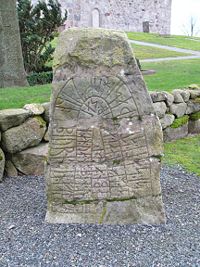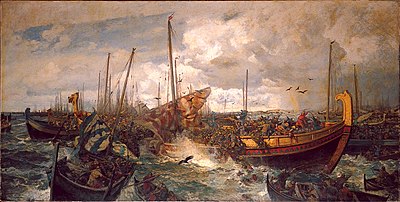Jomsvikings

The Jomsvikings were a possibly legendary company of Viking mercenaries or brigands of the 10th century and 11th century, dedicated to the worship of such deities as Odin and Thor. They were staunchly pagan, but they reputedly would fight for any lord able to pay their substantial fees, and occasionally fought alongside Christian rulers. According to the Norse sagas (particularly the Jómsvíkinga saga, King Olaf Tryggvasson’s Saga, and stories found in the Flatey Book), their stronghold Jomsborg was located on the southern shore of the Baltic Sea, but the exact location is disputed by modern historians and archeologists. Most scholars locate it on the hill Silberberg north of the town of Wolin on Wolin island.[1][2][3] Jomsborg is thought to be identical with "Jumne", "Julin" and "Vineta" mentioned in medieval Danish and German records.[3]
The legend of the Jomsvikings appears in some of the Icelandic sagas from the 12th and 13th centuries. The existence of Jomsborg is a matter of debate in historical circles, due to the scarcity of primary sources. There are no contemporary sources mentioning the names Jomsvikings and Jomsborg, but there are three contemporary runestones and several contemporary lausavísur held to refer to one of their battles.[4]
The Jomsviking code

The Saga of the Jomsvikings relates that the Jomsvikings were highly selective in deciding whom to admit to their order. Membership was restricted to men of proven valor between 18 and 50 (with the exception of a boy named Vagn Åkesson, who defeated Sigvaldi Strut-Haraldsson in single combat at the age of 12). In order to gain admission, prospective members were required to prove themselves with a feat of strength, often taking the form of a ritual duel, or holmgang, with a Jomsviking.
Once admitted, the Jomsvikings required adherence to a strict code of conduct in order to instill a sense of military discipline among its members. Any violation of these rules could be punished with immediate expulsion from the order. Each Jomsviking was bound to defend his brothers, as well as to avenge their deaths if necessary. He was forbidden to speak ill of his fellows or to quarrel with them. Blood feuds between members were to be mediated by Jomsviking officers. Jomsvikings were forbidden to show fear or to flee in the face of an enemy of equal or inferior strength, though orderly retreat in the face of vastly outnumbering forces appears to have been acceptable. All spoils of battle were to be equally distributed among the entire brotherhood. No Jomsviking was permitted to be absent from Jomsborg for more than three days without the permission of the brotherhood. No women or children were allowed within the fortress walls, and none were to be taken captive. It is unclear, however, whether members were forbidden marriage or liaisons with women outside the walls.
History
Historians still debate the accuracy of the accounts of the Jomsvikings. Some maintain that the order was entirely legendary. The site of their headquarters has never been conclusively located, so confirming the tales of their exploits is somewhat difficult.
There are different accounts for the origins of the order. Gesta Danorum (book 10) tells that a settlement named Julinum was conquered by the King of Denmark, Harald Bluetooth, who gave it to the Swedish prince Styrbjörn the Strong. Harald then provided Styrbjörn with a strong force with which Styrbjörn terrorized the seas. The Knýtlinga saga agrees by giving Harald as the founder of the Jomsvikings, but the story of Styrbjörn is not connected to the Jomsvikings. The Jómsvíkinga saga says that the settlement was founded by Palnatoke, receiving the location from the mythical Wendish ruler Burislav. Styrbjarnar þáttr Svíakappa and Eyrbyggja saga agree with all previously mentioned versions by making Styrbjörn take command of the Jomsvikings after they already had been established.[5] Styrbjarnar þáttr Svíakappa also tells that among the Norse there were many men from the "East land" arriving at Jomsborg, suggesting that it was a settlement of mixed ethnicity.

Accounts of their size vary. Jomsborg, in various sources, is supposed to have held anywhere from 30 to 300 ships in its harbor, with Jomsviking chieftains including Palnatoke, Styrbjörn the Strong, Sveyn Forkbeard, Sigvaldi Strut-Haraldsson, Thorkell the High, and Hemeng.
Gesta Danorum (book 10), Styrbjarnar þáttr Svíakappa and Eyrbyggja saga relate that in the early 980s, the exiled Swedish prince Styrbjörn the Strong brought the Jomsvikings to a devastating defeat against Styrbjörn's uncle Eric the Victorious at the Battle of the Fýrisvellir, Uppsala, in 984 or 985, while trying to take the crown of Sweden by force of arms.[5] The fact that the Jomsvikings lost was attributed to a pact that the Swedish king Eric made with Odin. Three runestones, the Högby Runestone (the brave champion Asmund fell on the Fyrisvellir), one of the Hällestad Runestones labelled DR 295 (he did not flee at Uppsala) and the Sjörup Runestone (He did not flee at Uppsala, but slaughtered as long as he had a weapon), from this time relate to deaths with honour at Uppsala, probably three Jomsvikings. The battle is also commemorated, in poetry, by the Icelandic skald Þórvaldr Hjaltason, who took part in the battle on the Swedish side.
Jómsvíkinga saga tells that in 986, they attacked Haakon Jarl in Norway and were defeated in the Battle of Hjörungavágr. The Jómsvíkinga saga ends with a brief explanation of the battle's aftermath, and, in fact, points to this battle as the beginning of the end for the Jomsvikings.

After these two decisive defeats, the power of the Jomsvikings waned, but Olaf Trygvasson's Saga relates that they played a decisive, if treacherous, role in the Battle of Svolder in 1000. At Svolder, a Jomsviking force led by Sigvald Jarl abandoned King Olaf of Norway and joined forces with his enemies to annihilate his fleet. This action may have been intended to fight the Christianization of Scandinavia which had been forcibly promoted by Olaf . As it happened though, the Danish king who won the Norwegian throne when the seabattle ended, Sweyn Forkbeard, was (at least nominally) a Christian. He and his father, Harald Bluetooth, the king of Denmark are reported to have been baptized in 965.
Jomsvikings are also reported to have raided eastern England in 1009, and made forays into various Scandinavian territories during the early 11th century. Around 1013 the Jomsvikings were campaigning in England on behalf of Sveyn Forkbeard, yet switched sides, maybe in a ruse to get their own Danegeld from the English, while the main Viking invasion force drove Ethelred the Unready to Normandy. Their decline continued over the next few decades. In 1043, according to the Heimskringla, Magnus I of Norway decided to put an end to the Jomsviking threat. He sacked Jomsborg, destroyed the fortress and put the surviving brethren to death.
Though they were staunchly Pagan, the institutions of the Jomsvikings in some ways anticipated those of the Christian Knightly Orders of the later Middle Ages.
Archaeological evidence

Runestones are counted as historic documents about the events of the Viking Age in Scandinavia. The following four runestones may mention Jomsvikings[citation needed] who died with Styrbjörn the Strong south of Uppsala. Note that the first runestone mentions a warleader named Toki Gormsson and he may be a son of the Danish king Gorm the Old, an interpretation which fits the fact that Styrbjörn was allied with another son of Gorm, Harald Bluetooth.
- One of the Hällestad Runestones labelled DR 295 in Skåne says: Áskell placed this stone in memory of Tóki Gormr's son, to him a faithful lord. He did not flee at Uppsala. Valiant men placed in memory of their brother the stone on the hill, steadied by runes. They went closest to Gormr's Tóki.
- The Sjörup Runestone, Skåne, relates: Saxi placed this stone in memory of Ásbjörn Tófi's/Tóki's son, his partner. He did not flee at Uppsala, but slaughtered as long as he had a weapon.
- On the Högby Runestone, it says The good freeman Gulli had five sons. The brave champion Asmund fell on the Fyris.
- The Karlevi Runestone was raised by Danish warriors in memory of the war chief on the island of Öland near the waterway which was passed by the Jomsvikings when they went to Uppsala and back. The stone is contemporary with the battle mentioned on the previous runestones and it is consequently possible that the stone was raised by Jomsvikings in memory of their lord.[6]
In fiction
Jomsvikings are the focus of the E. R. Eddison's novel Styrbiorn the Strong,[7] and Horned Helmet,[8] a juvenile historical novel by Henry Treece. Fictionalized versions of the Jomsborg (under the name "Jormsvik") and the Jomsvikings appear in Guy Gavriel Kay's novel The Last Light of the Sun, which is set in a fictional world that closely parallels 9th century Britain and Scandinavia.[9]
In Tim Severin's Viking series, Thorgils spends time amongst the Jomsvikings, although they are a smaller, older, and weaker force. The legendary Jomsburgers also appear in Creative Assembly's Medieval Total War Viking Invasion expansion pack, though they are called Joms Viking. They are the most highly skilled warrior available to the Vikings.
The Jomsvikings also appear in The Long Ships by Frans G. Bengtsson.
The short story "The King of Norway" by Cecelia Holland has at its center the story of the Battle of Hjörungavágr.
In the manga Vinland Saga, by Makoto Yukimura, the Jomsvikings play a crucial part, where some of the main characters are based on Jomsvikings from the Sagas such as Thorkell the High and Canute the Great. The manga depict them as an elite force under Sven then Knut during their invasion of England, while trying to keep their waning influence on the court. It is also said that Thorfinn's father Thors was a Jomsviking until he converted to christianism, fleeing Jomsborg with his wife. This led him to be considered as a traitor and being ambushed by the band of Askeladd.
In the The Old Gods DLC for the Paradox Interactive PC game Crusader Kings 2 the Jomsvikings serve as a Norse pagan version of the Christian holy orders.
Modern reenactment
The legend of the Jomsvikings has inspired a modern reenactment movement. The "Army of Jomsborg" seek to accurately portray Vikings of the 10th and 11th centuries. Their focus is on live-steel combat, though crafts are practiced by some members. The organization has branches in Europe, Canada, USA, and elsewhere.
See also
Primary sources
This list is not exhaustive:
- Jómsvíkinga saga
- Jómsvíkingadrápa
- Heimskringla
- Styrbjarnar þáttr Svíakappa
- Eyrbyggja saga
- Gesta Danorum
- Olaf Tryggvasson's Saga[disambiguation needed]
Notes and references
- ^ Nordisk familjebok
- ^ Jones 127; Kunkel passim.
- ^ a b Johannes Hoops, Herbert Jankuhn, Heinrich Beck, Reallexikon der germanischen Altertumskunde Band 16, 2nd edition, Walter de Gruyter, 2000, pp.120-121, ISBN 3-11-016782-4
- ^ For the historiocity of the Jomsvikings and the Saga of the Jomsvikings; for a discussion of different views on the subject, see Jones 127 at n.1. Jones regards the Saga as fictional, but finds arguments that the Jomsvikings themselves could not have existed unconvincing.
- ^ a b Eyrbyggja Saga § 29 (Palsson 83).
- ^ The article Karlevistenen in Nordisk familjebok (1910).
- ^ Ayr Co Publishing, 1978
- ^ Puffin, 1968
- ^ Roc, 2004.
Sources
- Hollander, Lee M., Trans. The Saga of the Jomsvikings. University of Texas Press, 1989.
- Jones, Gwyn. A History of the Vikings. 2d ed. Oxford Univ. Press, USA, 2001.
- Kunkel, O. and K.A. Wilde. Jumne, 'Vineta', Jomsborg, Julin: Wollin. Stettin, 1941.
- Palsson, Hermann, et al., translators. Eyrbyggja Saga. Penguin Classics, 1989.
- Sturlason, Snorre, and Erling Monsen (Editor). Heimskringla: Or the Lives of the Norse Kings. Dover Publications, 1990.
External links
- Jómsvíkinga saga from heimskringla.no
- Northvegr.org
- The Jomsvikings - Army of Jomsborg, Viking Age Re-enactment with Chapters all over the World (Combat Reenactment, Living History)
